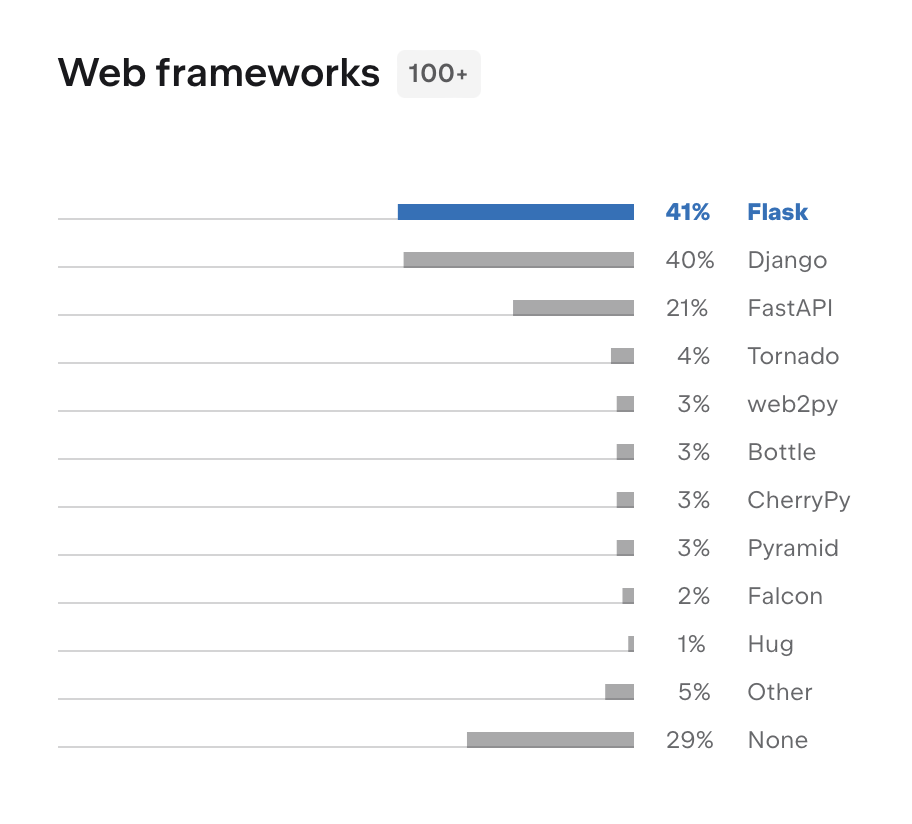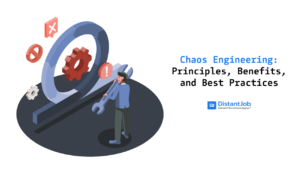Python frameworks offer the basic infrastructure for developers to build a Python software application. By providing a well-defined structure for app development, developers can not only reduce the development time but also focus on the core application logic instead of routine elements.
Being one of the most used programming languages, with over 49.23% of global developers currently using it, Python is well known for its ability to create complex, multi-protocol applications while maintaining a concise syntax.
However, despite its popularity, developers still need to tackle a range of challenges, from managing web application scalability to navigating the complexities of data analysis and asynchronous programming.
Here’s where Python frameworks come into play as they provide invaluable assistance, allowing developers to streamline the development process, enhance code quality, and more. Let’s go over the 11 most popular Python frameworks, exploring their optimal uses and standout features.
Types of Python Frameworks
Python frameworks can be categorized into three main types:
1. Full-Stack Framework
A full-stack framework provides a set of tools for developing both the front-end and back-end components of web applications. They typically include features for routing, templating, database interaction, authentication, and more.
2. Microframework
Microframeworks are lightweight and minimalist frameworks focused on simplicity and flexibility. They offer essential tools for building web applications without the complexity of full-stack frameworks.
Microframers are suitable for small projects or for developers who are looking to have more control over their code.
3. Asynchronous Framework
Asynchronous frameworks are designed to facilitate the development of concurrent and non-blocking applications. They use asynchronous programming paradigms to handle multiple I/O operations concurrently without blocking the execution flow.
Top 2024 Python Frameworks
This list covers the best Python frameworks in 2024, with both the tried-and-tested favorites as well as the up-and-coming contenders. We explore their main features and best use cases, helping you decide which one is the better choice for your projects.
1. Flask
Flask is currently the #1 Python framework, with the highest percentage of use between developers.

Considered a microframework, Flask comes with basic functionality, but what makes it unique is that it allows easy expansion, allowing you to join libraries with each other easily.
Flask provides essential tools and features for web development, such as URL routing, template, rendering and HTTP request handling, while allowing developers the flexibility to add additional functionality through its ecosystem of extensions.
Unlike some larger frameworks, Flask does not impose a specific structure or set of dependencies on developers, allowing for greater freedom and customization in how applications are built.
For example, if you need an ORM (Object-Relational Mapping) for database interactions, you can choose SQLAlchemy or Django ORM and integrate it with Flask using Flask-SQLAlchemy. Similarly, for form validation, you could use WTForms. This approach lets developers tailor their stack to their precise requirements.
Use Cases:
- API Development
- Microservices
- Prototyping
2. Django
The Django framework is a high-level Python web framework that offers all the tools required to build a web application within a single package, from low-to-high-end. Founded by the principle of DRY, “Don’t Repeat Yourself,” Django aims to simplify the creation of complex, database-driven websites.
Django is structured around the Model-View-Template (MVT) pattern, a variant of the traditional Model-View-Controller (MVC) architecture.
In MVT, the model defines the data structure using Django’s Object-Relational Mapping (ORM) layer, allowing developers to interact with SQL databases through Python code rather than writing raw SQL queries. This design facilitates a clean separation of concerns, with models managing the database, views handling the business logic, and templates dealing with presentation.
Often described as an “all-inclusive” framework, Django provides almost everything a developer needs to build a web application without requiring external libraries for basic functionalities. This includes an ORM for database operations, authentication mechanism, URL routing, admin panel and more.
Here’s a simple example of how Django’s ORM can be used to define a database schema and perform operations:
from django.db import models
class User(models.Model):
username = models.CharField(max_length=100)
email = models.EmailField()
# Creating a new user would be as simple as:
# User.objects.create(username='john', email='[email protected]')Django also places a strong emphasis on security, offering built-in protections against many common vulnerabilities, such as SQL injection, cross-site scripting (XSS), cross-site request forgery (CSRF), and clickjacking.
Use Cases:
- E-commerce Platforms
- Content Management Systems (CMS)
- Social Media Sites
3. CherryPy
CherryPy is a minimalist, open-source Python framework designed for the rapid development of web applications. It strikes a unique balance in the spectrum of Python web frameworks—offering a richer set of out-of-the-box functionalities than typically expected from a micro-framework like Flask, yet maintaining a simplicity not found in full-stack solutions like Django.
It stands out for its simplicity and its ability to run Python applications as web applications with minimal code changes. You can set up a basic web server in CherryPy with just a few lines of code:
import cherrypy
class HelloWorld:
@cherrypy.expose
def index(self):
return "Hello World!"
if __name__ == '__main__':
cherrypy.quickstart(HelloWorld())This simplicity extends to CherryPy’s deployment capabilities, eliminating the need for a separate WSGI server setup like Apache or Nginx for running web applications.
It allows developers to build web applications with the same principles as object-oriented programming, leading to cleaner, more maintainable code. CherryPy’s seamless integration of Python’s object-oriented paradigm enables developers to structure their web applications as a cohesive collection of objects.
Additionally, CherryPy distinguishes itself with an assortment of built-in tools addressing common web development requirements—ranging from static content serving and session management to authentication and caching. This comprehensive toolset equips developers to handle various web development tasks efficiently without the complexity of integrating numerous external libraries.
Use Cases:
- Small to Medium Web Applications
- RESTful APIs Prototyping and Proof of Concept
4. Bottle
Bottle is a micro web framework for Python that is designed for building simple web applications. Its ease of use, simplicity and single-file deployment make it a popular choice among developers who need to create a lightweight web service or application rapidly.
It also provides an efficient avenue for developers to build web interfaces for devices or projects with limited resources, enhancing interaction without needing extensive hardware control capabilities.
This Python microframework also comes with a built-in development server, making it easy to develop and test applications locally. Additionally, it is fully compatible with any WSGI (Web Server Gateway Interface) server, which means Bottle applications can be deployed to production environments using a variety of WSGI-compatible servers for increased scalability and performance.
Bottle’s simplicity and straightforward routing system make it an excellent choice for developing RESTful APIs. Defining routes for different HTTP methods is simple, facilitating the creation of APIs that adhere to REST principles.
Here’s an example:
from bottle import route, run, request
@route('/api/items', method='GET')
def get_items():
# Logic to retrieve and return items
pass
@route('/api/items', method='POST')
def add_item():
item = request.json
# Logic to add the item
return "Item added"This flexibility in handling different HTTP methods with ease makes Bottle a solid option for back-end API services that need to be lightweight and efficient.
Use Cases:
- Prototyping
- Small web applications
- Personal projects
5. Web2Py
Web2Py is a full-stack web framework used for the rapid development of fast, scalable, secure and portable database-driven web applications.
It is designed to guide you into the best practices in web development, with a focus on ease of use, a code-less approach to configuration, and the DRY (Don’t Repeat Yourself) principle.
Web2py includes everything needed to build a web application: its own web server, a relational database, a web-based interface, and a ticketing system to manage errors. It supports multiple popular databases out of the box, with no need for separate drivers or SQL.
Creating a new database table in Web2py can be as simple as defining a model file in the application’s “models” directory:
db.define_table('person',
Field('name'),
Field('age', 'integer'))Additionally, Web2py applications are portable across a wide range of operating systems and cloud platforms. The framework’s architecture supports scalability, capable of handling both small and large-scale applications.
For example, a Web2py application developed on a local machine can be deployed to Google App Engine, Amazon EC2, or any WSGI-compatible web server without any changes to the application code.
Use Cases:
- Rapid prototyping
- Database-driven web applications
- Scientific and data analysis applications
6. Sanic
Sanic is an asynchronous web framework for Python designed to provide a simple way to develop fast HTTP responses via asynchronous request handlers. It is built on top of the asyncio library, which allows for asynchronous programming, enabling the handling of large numbers of simultaneous client connections.
One of the key features that set Sanic apart is its built-in support for asynchronous request handlers, making it particularly suitable for IO-bound and high-performance asynchronous applications.
This allows you to write non-blocking code that can handle multiple requests concurrently, significantly improving the throughput of web services.
from sanic import Sanic
from sanic.response import json
app = Sanic("App Name")
@app.route("/")
async def test(request):
return json({"hello": "world"})
if __name__ == '__main__':
app.run(host="0.0.0.0", port=8000)This example shows how to define an asynchronous route handler, which can improve performance by allowing other tasks to run in the background until the response is ready.
Additionally, another key feature of Sanic is that it has built-in support for WebSockets, making it easy to develop real-time web applications. WebSocket support is essential for applications that require a persistent, open connection between the client and server to facilitate real-time data transfer.
Use Cases:
- Building high-performance, asynchronous web services and APIs.
- Real-time applications
- Applications requiring high concurrency and IO-bound operations, such as aggregators or proxy services.
7. Tornado
Tornado is an open-source, asynchronous Python web framework that allows the development of scalable, non-blocking web applications.
Originally developed for FriendFeed, Tornado is particularly valuable for its ability to manage thousands of connections simultaneously, making it an excellent choice for long–polling, WebSockets and other applications that require a long-lived connection to each user.
Tornado’s built-in support for asynchronous I/O operations makes it uniquely suited for applications that require high performance and scalability under load. It uses a non-blocking network I/O, which allows it to support tens of thousands of simultaneous connections, ideal for real-time web services.
Tornado can be used alongside other Python frameworks and libraries, allowing for integration into larger existing applications where Tornado’s asynchronous capabilities or WebSocket support can enhance functionality.
Use Cases:
- Real-time web applications
- Highly concurrent applications
- Microservices and APIs
8. FastAPI
FastAPI is a modern, fast (high-performance) web framework for building APIs with Python 3.6+ based on standard Python-type hints.
This is one of the fastest frameworks for Python, thanks to its Starlette framework foundation for handling asynchronous requests and its Pydanic library for data validation. This combination not only makes FastAPI quick but also efficient in terms of developer time and server resources.
Additionally, FastAPI is designed to be easy to use, with intuitive syntax that makes developing robust APIs straightforward. Its dependency on Python 3.6+ type hints ensures that the code is clean and easy to understand.
Another major advantage of FastAPI is that it automatically generates interactive API documentation using Swagger UI and ReDoc, making it easy for developers to test and document their APIs. This auto-generated documentation is a significant advantage for maintaining up-to-date API docs.
By simply running the FastAPI app, developers get automatic API documentation at / docs (Swagger UI) and / redoc (ReDoc) endpoints without writing any extra documentation code.
Use Cases:
- RESTful APIs.
- Creating APIs for data science and machine learning models
- Developing real-time web applications using WebSockets.
9. TurboGears
TurboGears is a Python web application framework that combines different tools to offer a full-stack solution for web development.
It’s designed to help you build data-driven and scalable web applications in a much more simple and efficient way. As it adheres to the Model-View-Controller (MVC) architecture, it facilitates the development of clean, maintainable code by separating concerns within the application.
TurboGears integrates with SQLAlchemy for object-relational mapping (ORM), which allows you to work with multiple databases and perform complex queries with ease.
In a TurboGears application, you define your data models by subclassing sqlalchemy.ext.declarative.declarative_base(). These model classes map Python objects to database tables. SQLAlchemy handles the conversion between your Python code and the appropriate SQL queries for the underlying database, abstracting away the complexities of direct database manipulation.
Defining a simple user model might look something like this:
from sqlalchemy import Column, Integer, String
from sqlalchemy.ext.declarative import declarative_base
Base = declarative_base()
class User(Base):
__tablename__ = 'users'
id = Column(Integer, primary_key=True)
username = Column(String(50), unique=True)
email = Column(String(50), unique=True)
Additionally, TurboGears supports multiple templating engines, including Genshi and Jinja2, providing you with the flexibility to choose the one that fits your needs. Another reason why developers choose TurboGear is due to its powerful command-line tools for scaffolding, development and deployment tasks, which streamlines the workflow.
Similarly, it offers built-in support for creating RESTful web services, making it easier to develop APIs that can be consumed by web or mobile applications.
Use Cases:
- Rapid prototyping
- Data-driven applications
- Complex web applications
10. Pyramid
The Pyramid framework is a lightweight, flexible and high-performance Python web framework. Under its premise of “Start small, finish big, stay finished framework,” it allows you to create web applications that range from simple to complex with minimal setup yet scales to support complex applications.
It differentiates from other frameworks like Django because Pyramid is trivial to customize, allowing you to create features in ways that the author of the framework hadn’t planned or considered.
Additionally, Pyramid provides you with the freedom to choose the layout of your project, the database layer, and how they handle requests and responses.
For example, you have the flexibility to select whatever database interaction method suits your project best. You can use another ORM like Peewee or integrate with NoSQL databases, as Pyramid applications are not limited to their use.
Overall, Pyramid’s philosophy emphasizes giving you the freedom to choose the most appropriate tools and practices for your specific needs rather than making you use a particular set of technologies or methodologies.
Another interesting feature that Pyramid offers is its dual routing mechanisms: traversal and URL dispatch. These features offer you different ways to map URLs to code, giving you flexibility in how you structure your application’s routing logic.
Use Cases:
- API development
- Content management systems (CMS)
- E-commerce platforms
11. Kivy
Kivy is an open-source Python framework for developing multitouch applications. It enables the creation of applications that are capable of running on multiple platforms, including Windows, macOS, Linux, iOS, and Android, from a single codebase.
At its core, Kivy is designed to handle multitouch, mouse, keyboard, and other input forms, making it well-suited for developing applications that require interactive touch interfaces.
Additionally, it comes with a set of pre-built widgets for building user interfaces, including buttons, text inputs, sliders and more. These widgets are highly customizable and can be styled or extended to fit the specific needs of an application.
Kivy is well known for its powerful graphics engine. Built on top of OpenGL ES 2, Kivy’s graphics engine allows for the creation of smooth and dynamic GUIs with effects, transitions, and animations. This makes it possible to develop visually appealing applications.
You can also simplify the layout design process and separate the UI from the application logic through its custom-designed language (KV) for defining user interfaces and binding logic.
Use Cases:
- Mobile applications
- Interactive installations
- Game development
Why Use a Python Framework
By providing pre-built components, design patterns and best practices, Python frameworks are ideal for significantly reducing time, enhancing productivity and streamlining the process of building applications.
These are the main benefits of using them:
- Rapid development
- Consistency
- Scalability
- Secure applications
- Abstraction of complexity
- Extensibility
- Cross-platform compatibility
- Performance optimization
Get Started with Your Python Application
The best aspect of Python frameworks is how they allow you to optimize and make app development easier and more effective. Depending on your project’s needs, you’ll find the most suitable Python framework from microframeworks like Flask or Bottle, full-stack frameworks like Django or TurboGears, or asynchronous frameworks like Tornado and Sanic, among others.
It’s not a matter of becoming an expert in all of them but learning how to choose the one that aligns with your project’s requirements.
Also, keep in mind that the best way to create successful Python applications goes beyond the right toolkit. It starts by building the right team. If you’re looking for an expert Python developer, we can help you.
At DistantJob, being an IT staffing agency for over a decade, we’ve carefully designed a recruitment process to successfully match companies with talented developers. Want to know more? Let’s talk.
FAQ
A Python framework is a pre-established set of tools and features that provide a structured foundation for developing software applications using the Python programming language.
These frameworks offer standardized solutions for common development tasks, like handling web requests, managing database interactions, and structuring application code.
A library is a set of reusable code pieces that a developer can incorporate into their own code, choosing when to use them, while a framework sets the overall structure and flow of an application, inverting control by calling upon the developer’s code according to its pre-defined template or operations.
Flask is a great choice for beginners due to its simplicity, minimalistic and unopposed approach, allowing beginners to quickly understand and start creating web applications without being overwhelmed by too many components.




